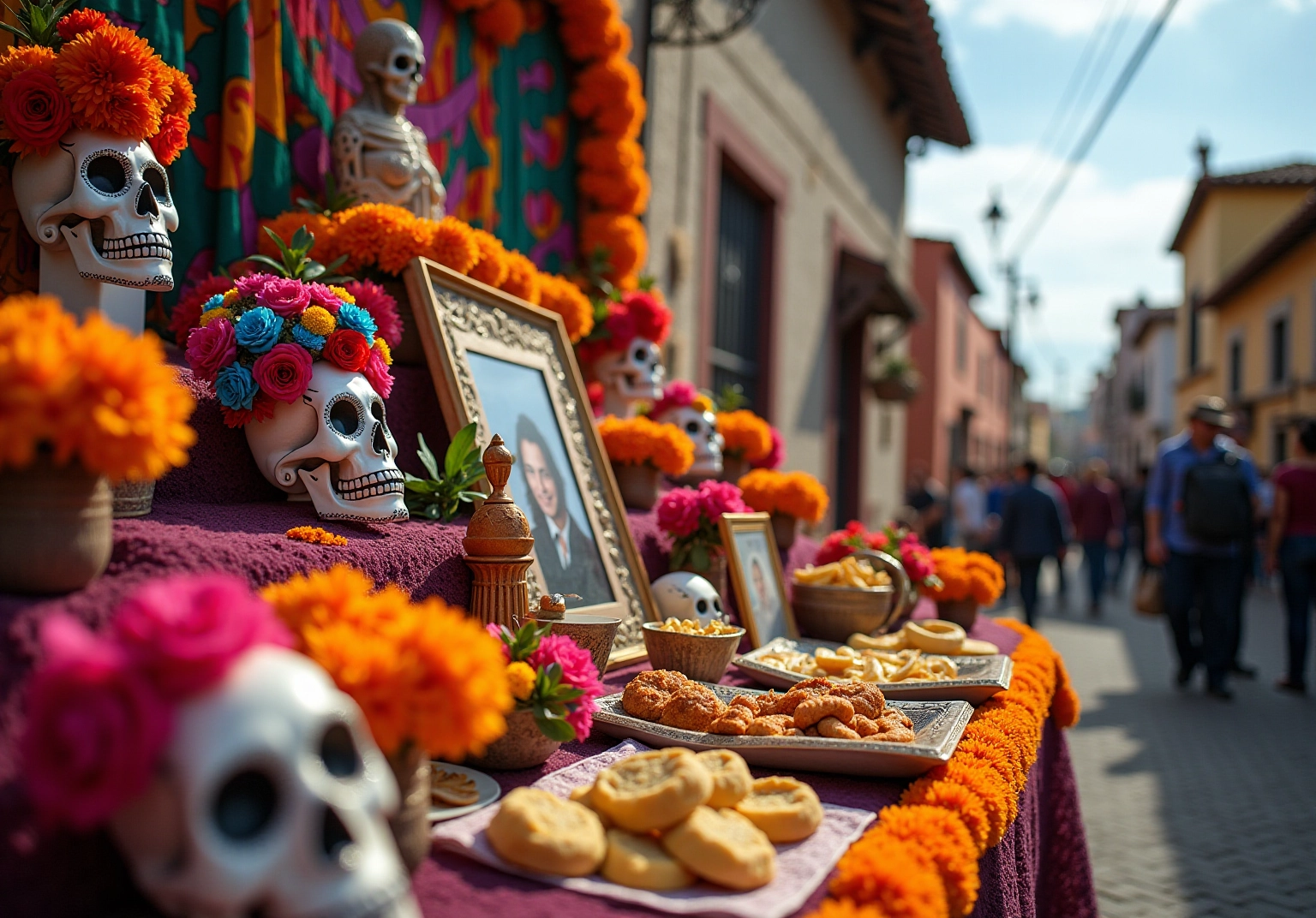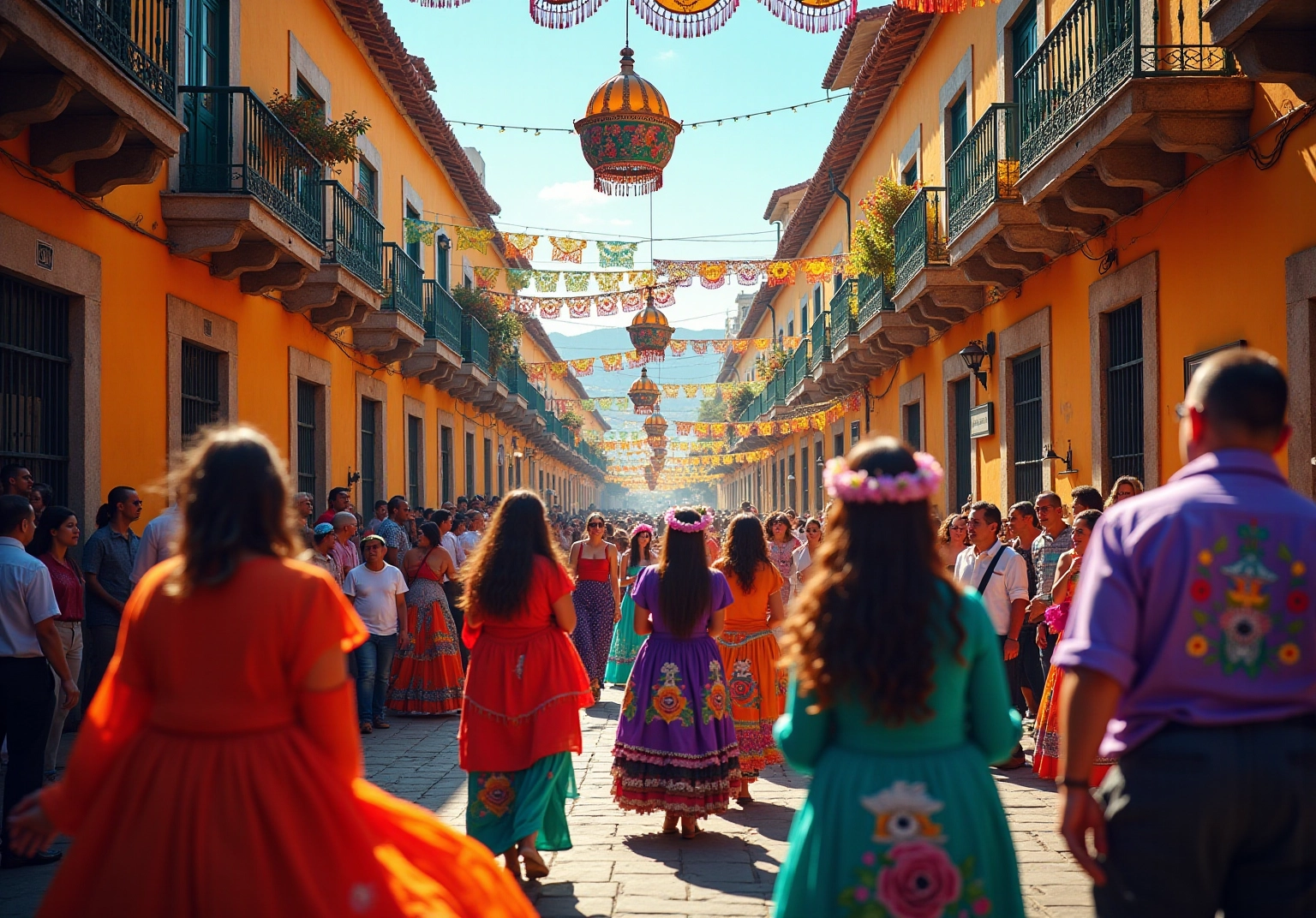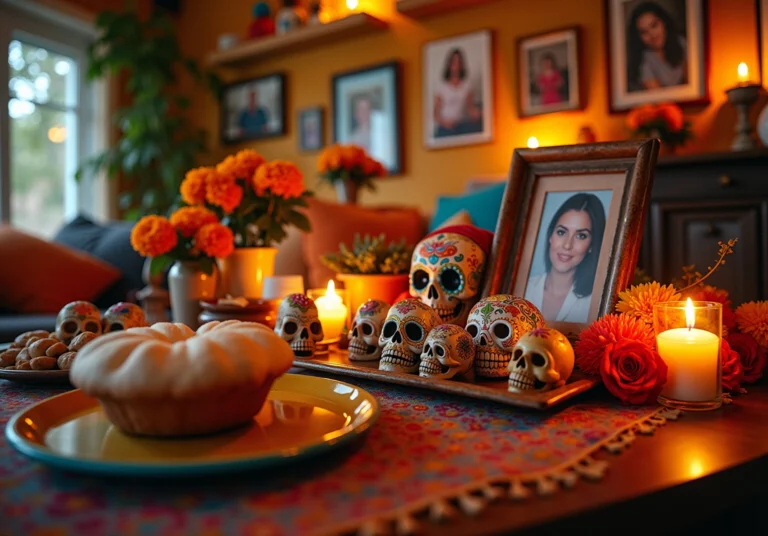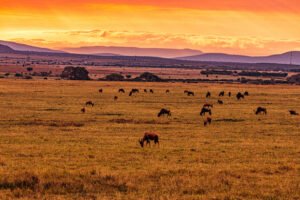Overview
This article is your friendly guide to experiencing the vibrant Día de los Muertos celebrations in Mexico! Celebrated on November 1st and 2nd, this holiday is all about honoring our beloved deceased through heartwarming traditions like creating ofrendas and joining in lively parades. It’s a beautiful blend of indigenous and Catholic beliefs that truly reflects a deep appreciation for life and memory among around 80% of Mexicans.
Imagine walking through colorful streets filled with music and laughter, as families gather to remember their loved ones. You’ll find that the atmosphere is both festive and reflective, making it a unique experience that you won’t want to miss. Each ofrenda, or altar, tells a story, showcasing photos, favorite foods, and cherished items of those who have passed away.
As you plan your visit, think about the key locations where you can immerse yourself in this celebration. From bustling markets to serene cemeteries, each spot offers a different perspective on how this holiday is celebrated. Trust me, every moment spent here will leave you with unforgettable memories and a deeper understanding of Mexican culture.
So, are you ready to embark on this colorful journey? Let’s dive into the heart of Día de los Muertos together, exploring its significance, customs, and the joy it brings to those who celebrate!
Key Highlights:
- Día de los Muertos is celebrated on November 1st and 2nd in Mexico, honouring deceased loved ones and rooted in ancient indigenous practises.
- The holiday blends Catholicism with indigenous beliefs, allowing spirits to visit their families through ofrendas (altars) adorned with marigolds, photographs, and favourite foods.
- Approximately 80% of Mexicans participate in the festivities, emphasising the celebration of life and memory rather than mourning.
- Prominent cultural figures like Octavio Paz and Frida Kahlo highlight the holiday’s role in understanding legacies and identity.
- Major celebration locations include Oaxaca for parades, Mexico City for the Great Parade, Pátzcuaro for candlelit boat processions, and Janitzio Island for unique traditions.
- Key customs include creating ofrendas, visiting cemeteries, participating in parades, and cooking traditional foods like pan de muerto.
- Local events during the celebrations include workshops, cultural performances, food festivals, and guided tours that enhance cultural appreciation.
- Día de los Muertos is recognised by UNESCO as part of the intangible heritage of humanity, reflecting a rich historical legacy.
Introduction
Día de los Muertos, or the Day of the Dead, is a captivating celebration that goes beyond mere remembrance. It invites you to honor your ancestors through vibrant rituals and heartfelt traditions! This deeply rooted Mexican holiday takes place on November 1st and 2nd, and it’s not just a time of mourning; it’s a jubilant expression of life. Families gather to create ofrendas, share meals, and participate in colorful parades.
What makes this celebration truly unique is the blend of ancient indigenous beliefs and contemporary practices that shape its observance across various regions of Mexico. So, how can you fully immerse yourself in this rich cultural tapestry and ensure a meaningful experience during the Day of the Dead festivities? Let’s explore together!
Understand the Significance of Day of the Dead
Día de los Muertos, or the day of the dead celebrations in Mexico, is a vibrant tradition celebrated on November 1st and 2nd, dedicated to honoring our beloved deceased. Rooted in ancient indigenous practices, especially from the Aztec civilization, this holiday embodies the beautiful belief that death is an integral part of life. It allows the spirits of the departed to return and visit their families! The event weaves together aspects of Catholicism and indigenous beliefs, creating a rich tapestry that mirrors Mexico’s diverse heritage.
Understanding the significance of Día de los Muertos truly enhances your experience with its customs. Imagine crafting ofrendas (altars) adorned with marigolds, photographs, and the favorite foods of those who’ve passed. These altars serve as a heartfelt link between the living and the deceased, inviting spirits to partake in the gathering. And don’t forget about the cemetery vigils! Families come together to honor their ancestors, emphasizing the joy and reverence inherent in these practices.
Did you know that roughly 80% of Mexicans actively engage in these festivities? That’s a testament to the importance of remembering and honoring those who have departed. Cultural anthropologists highlight that the day of the dead celebrations in Mexico aren’t just a day of mourning; they’re a lively celebration of life, where love and memory intertwine. Prominent figures like Octavio Paz and Frida Kahlo have shared their thoughts on this holiday, emphasizing its role as a sincere tribute that nurtures a deeper understanding of the legacies left by our cherished ones and the narratives that shape our identities.
The rituals surrounding the day of the dead celebrations in Mexico have beautifully evolved over time, adapting to contemporary influences while keeping their core essence intact. You’ll find regional variations across Mexico that showcase unique customs and practices, which enrich the day of the dead celebrations in Mexico. Artistic elements, such as papel picado and the intricate designs of ofrendas, highlight the creativity and artistry that define this cultural observance. As Karen LeBlanc of The Design Tourist points out, these artistic expressions not only celebrate life but also tell the story of a culture deeply rooted in tradition and creativity. This immersive creative exploration makes the experience of Día de los Muertos a profound journey into the heart of Mexican heritage!

Plan Your Visit: Dates and Locations for Celebrations
The day of the dead celebrations in Mexico, also referred to as Día de Muertos, are vibrant festivities primarily observed on November 1st and 2nd, with events starting as early as October 28th. If you’re looking to immerse yourself in this colorful tradition, here are some must-visit locations:
- Oaxaca: Often considered the heart of Day of the Dead festivities, Oaxaca is famous for its elaborate parades and stunning street decorations. The day of the dead celebrations in Mexico typically begin on October 31st and wrap up on November 2nd, drawing thousands of visitors eager to soak in the local culture.
During the day of the dead celebrations in Mexico, Mexico City transforms into a lively hub, hosting a grand parade and numerous events throughout its historic center. The Great Parade, inspired by a fictional event in the James Bond movie Spectre, has become a major attraction since its debut in 2016, welcoming over two million visitors in 2023!
-
Pátzcuaro, Michoacán: This charming town is known for its traditional celebrations, particularly the day of the dead celebrations in Mexico, which include enchanting candlelit boat processions on Lake Pátzcuaro. The magical atmosphere here captivates both locals and tourists alike.
-
Janitzio Island: Nestled in the center of Lake Pátzcuaro, this island showcases unique traditions and offers breathtaking views of the festivities, making it a must-see during the celebrations.
To truly enjoy the day of the dead celebrations in Mexico, I recommend arriving a few days early. This way, you can participate in lead-up activities like decorating altars and visiting cemeteries, which are key to the traditional experience. Plus, honoring local customs and etiquette enriches the overall experience and shows respect for the cultural significance of the Day of the Deceased, beautifully merging indigenous and Catholic traditions.

Engage with Traditions: Customs and Rituals to Experience
To fully immerse yourself in the vibrant traditions of the Day of the Dead, why not dive into these engaging customs and rituals?
- Creating an Ofrenda: Imagine constructing an altar in your home or at a cemetery to honor your deceased loved ones. This sacred space can be filled with photographs, favorite foods, and items that reflect their personalities. Traditional offerings often feature marigolds, sugar skulls, and candles, which serve to guide the spirits back to their families. It’s fascinating to note that more than 80% of families take part in creating ofrendas, making it a central element of the celebration!
- Visiting Cemeteries: Picture joining families as they gather in cemeteries to clean graves, decorate them with flowers, and share meals. This poignant ritual is a time for remembrance and honoring, where stories are exchanged, and memories are cherished. While it’s noted that a considerable number of families visit graveyards during the Day of the Living, it’s essential to verify specific statistics to ensure accuracy. The act of decorating graves with marigolds, which symbolize guidance for souls, is particularly meaningful during this time.
- Participating in Parades: Many cities host lively parades adorned with colorful costumes, music, and dancing. Embrace the festivities by dressing up, often as La Catrina, a symbol of death in Mexican culture. These parades not only celebrate life but also honor the deceased, creating a joyful atmosphere that unites generations.
- Cooking Traditional Foods: How about preparing traditional dishes like pan de muerto (bread of the dead) and mole to share with family and friends? The act of cooking and sharing food is a vital part of the celebration, symbolizing the enduring connection between the living and the dead. Engaging in these culinary traditions fosters a sense of community and remembrance, as families gather to enjoy meals that honor their ancestors.
By engaging in these traditions, you’ll not only enhance your understanding of the Day of the Departed but also forge enduring memories that honor the lives of those who have left. The Day of the Deceased, recognized by UNESCO as part of the intangible heritage of humanity, began with the Aztecs over 3,000 years ago, reflecting a rich historical legacy that continues to resonate today.
Participate in Local Events: Activities and Experiences
During the Day of the Dead, you’ll find a plethora of local events that offer unique experiences, immersing you in the vibrant culture of Mexico. It’s a chance to see travel through the creative lens of Karen LeBlanc:
- Workshops: Get ready to roll up your sleeves in hands-on workshops! You can learn to create traditional crafts like papel picado (decorative paper) and sugar skulls. These activities not only let you express your creativity but also deepen your appreciation for the significance behind these cherished decorations. It’s all about embodying the spirit of remembrance that LeBlanc emphasizes in her explorations.
- Cultural Performances: Don’t miss the lively performances featuring traditional music and dance, often held in public squares. These events celebrate Mexico’s rich artistic heritage, creating a festive atmosphere that invites you to participate and enjoy—just like the authentic experiences LeBlanc seeks to highlight in her travels.
- Food Festivals: Explore local food festivals showcasing traditional dishes linked to the Day of the Deceased. You’ll get to taste regional specialties while discovering their historical and cultural importance. It’s a culinary adventure that connects you to the local culture, a theme central to LeBlanc’s insights.
- Guided Tours: Consider joining guided tours centered on Day of the Deceased traditions. Local guides share valuable insights into the history and meaning of various customs, enhancing your understanding and appreciation of this vibrant celebration. This echoes LeBlanc’s belief in the importance of storytelling through travel.
These activities not only celebrate the lives of those who have passed but also foster a sense of community and connection among participants, making your experience during the Day of the Dead truly memorable. And don’t forget, the artisan market in Coyoacan on October 31 is a must-visit! It offers a fantastic chance to engage with local artisans and their crafts, further enriching your journey through the lens of authenticity and creativity.
Conclusion
Día de los Muertos, or the Day of the Dead, is a profound celebration in Mexico that honors the lives of those who have passed away. This vibrant tradition, celebrated on November 1st and 2nd, intertwines indigenous beliefs with Catholic practices, creating a rich cultural tapestry that reflects the deep-rooted heritage of the Mexican people. By understanding its significance, you can truly appreciate the heartfelt customs that make this holiday a unique and joyous occasion.
The article highlights various aspects of the Day of the Dead, including:
- The creation of ofrendas
- Cemetery vigils
- Lively parades
Each of these elements serves to connect the living with the deceased, fostering a sense of community and remembrance. Locations like Oaxaca and Mexico City offer spectacular experiences, and engaging in local customs—like cooking traditional foods or participating in workshops—enriches your understanding of this cherished celebration.
Ultimately, embracing the Day of the Dead isn’t just about observing traditions; it’s about celebrating life and the legacies left behind by loved ones. By participating in these festivities, you can forge meaningful connections with Mexican culture and honor the memories of those who have passed. As the Day of the Dead approaches, consider planning a visit to immerse yourself in this extraordinary celebration, where every moment is a reminder of the enduring bond between the living and the dead.
Frequently Asked Questions
What is Día de los Muertos?
Día de los Muertos, or the Day of the Dead, is a vibrant tradition celebrated in Mexico on November 1st and 2nd, dedicated to honoring deceased loved ones. It is rooted in ancient indigenous practices, especially from the Aztec civilization, and reflects the belief that death is an integral part of life.
How do people celebrate Día de los Muertos?
Celebrations include crafting ofrendas (altars) adorned with marigolds, photographs, and favorite foods of the deceased. Families also hold cemetery vigils to honor their ancestors, emphasizing joy and reverence in these practices.
What percentage of Mexicans participate in Día de los Muertos celebrations?
Approximately 80% of Mexicans actively engage in Día de los Muertos festivities, highlighting its significance in remembering and honoring those who have passed away.
How do cultural anthropologists view Día de los Muertos?
Cultural anthropologists view Día de los Muertos not just as a day of mourning but as a lively celebration of life, where love and memory intertwine.
What are some artistic elements associated with Día de los Muertos?
Artistic elements include papel picado and intricate designs of ofrendas, showcasing the creativity and artistry that define this cultural observance.
How have the rituals of Día de los Muertos evolved over time?
The rituals surrounding Día de los Muertos have evolved, adapting to contemporary influences while maintaining their core essence. Regional variations across Mexico showcase unique customs and practices.
What is the significance of crafting ofrendas?
Ofrendas serve as a heartfelt link between the living and the deceased, inviting spirits to partake in the gathering and allowing families to honor their loved ones.
Who are some prominent figures that have commented on Día de los Muertos?
Prominent figures like Octavio Paz and Frida Kahlo have emphasized the holiday’s role as a sincere tribute that nurtures a deeper understanding of legacies and narratives that shape identities.































